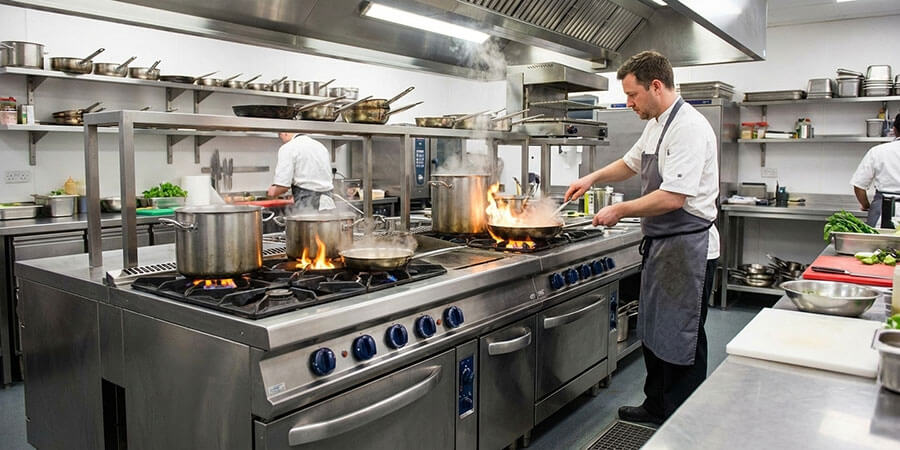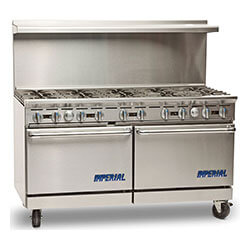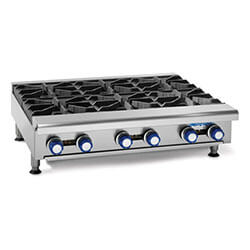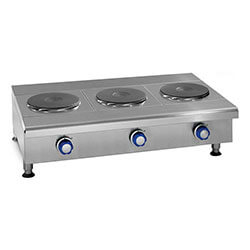Commercial Range Guide

Table of Contents
Commercial ranges are the workhorses of professional kitchens. Providing the primary cooking surface for sautéing, frying, boiling, simmering, and nearly every stovetop technique. Unlike residential stoves, commercial ranges deliver significantly higher heat output, more durable construction, and configurations designed for the demands of continuous restaurant service. Whether you need a full-size gas range with multiple ovens, a compact countertop hot plate for supplemental cooking, or a specialized wok burner for high-heat Asian cuisine, understanding the options ensures you select equipment matched to your operation's volume, menu, and utility infrastructure.
This guide covers the complete commercial range ecosystem: floor-model gas and electric ranges, countertop cooking units, stock pot burners for large-batch production, wok ranges for intense heat applications, and the accessories that complete your cooking line.
Gas vs Electric: The Fundamental Decision
Before exploring specific range types, the first decision is fuel source. Both gas and electric ranges have distinct advantages, and the right choice depends on your utility infrastructure, cooking style, and operational priorities.
Gas Ranges
Gas ranges remain the dominant choice in professional kitchens for good reason. Open flame cooking provides visual feedback, instant heat adjustment, and the ability to work with round-bottom cookware like woks. Gas burners deliver heat measured in BTUs (British Thermal Units), with commercial models ranging from 17,500 BTU per burner for standard cooking to 35,000+ BTU for high-heat searing.
Advantages:

- Instant heat adjustment; flame responds immediately to control changes
- Works with any cookware material and shape
- Visual flame feedback for experienced cooks
- Generally lower operating costs where natural gas is available
- Continues working during power outages
Considerations:
- Requires gas line infrastructure
- Produces combustion byproducts requiring robust ventilation
- Higher ambient heat in the kitchen
- Open flame safety considerations
Electric Ranges
Electric ranges offer advantages in locations without gas service, environments where open flames are prohibited, or kitchens prioritizing precise temperature control. Modern electric ranges use various heating technologies; from traditional coil elements to solid French plates and induction surfaces.
Advantages:

- No gas line required; operates on electrical service
- Reduced ventilation requirements (no combustion)
- Precise, consistent temperature control
- Cooler kitchen environment than gas
- Required in locations prohibiting open flames
Considerations:
- Slower heat response than gas flame
- Higher electrical infrastructure requirements
- May require 208V/240V/480V service
- Traditional elements don't provide visual heat feedback
When to Choose Each
| Factor: | Choose Gas: | Choose Electric: |
| Utility availability | Gas service installed | No gas, only electric |
| Cooking style | High-heat searing, wok, flame work | Precise simmering, controlled temps |
| Cookware | Round-bottom woks, varied materials | Flat-bottom only (traditional); any (induction) |
| Ventilation | Can accommodate robust hood systems | Limited ventilation options |
| Operating cost | Lower where gas is cheap | Variable by electric rates |
| Kitchen heat | Can tolerate higher ambient temps | Need cooler environment |
Types of Commercial Ranges
Gas Ranges (Floor Model)
Floor-model gas ranges are the standard workhorses of commercial kitchens. These units combine multiple burners on top with one or two ovens below, creating a complete cooking station in a single footprint. Available widths range from 24 inches (2-burner with oven) to 72+ inches (10-burner configurations with double ovens).
Restaurant Range vs Heavy-Duty Range: Commercial gas ranges fall into two general construction categories. Restaurant ranges (sometimes called medium-duty) offer solid performance at lower price points, suitable for most commercial kitchens with moderate use. Heavy-duty ranges feature thicker steel construction, more robust burner assemblies, and heavier grates designed for continuous high-volume operation. The price difference can be significant, expect to pay 2-3x more for heavy-duty construction, but the durability justifies the investment in demanding environments where equipment runs 12-16 hours daily.

Burner Configurations:
- 2-Burner: Compact units (24" wide) for small kitchens or as line supplements
- 4-Burner: Standard configuration (24-36" wide) for moderate volume
- 6-Burner: Popular choice (36-48" wide) balancing capacity and footprint
- 8-10 Burner: High-volume lines (48-72" wide) for large operations
BTU Output by Application:
| BTU Range: | Best For: |
| 17,500-25,000 BTU | Simmering, light sautéing, sauce work |
| 26,000-32,000 BTU | General cooking-sautéing, pan-frying, boiling |
| 33,000-35,000+ BTU | High-heat searing, rapid boiling, heavy-duty production |
Oven Options:
- Standard Oven: Full-size cavity below burners for roasting, baking, and holding
- Convection Oven: Fan-circulated air for faster, more even cooking
- Space Saver Oven: Reduced-depth cavity for ranges with storage bases or where full oven depth isn't needed
Top Configurations: Many gas ranges offer combination tops with griddles, charbroilers, or hot tops integrated alongside open burners:
- Open Burners with Grates: Standard configuration with individual burners and removable grates
- Burners + Griddle: Common configuration pairing 4-6 burners with a griddle section. Griddles are typically available in 12" increments (12", 24", 36", 48", etc.), making it easy to plan combination tops
- Burners + Charbroiler: Open-flame grilling surface integrated into the range top
- Hot Top (French Top): Solid steel surface heated from below; cooler edges for holding, hotter center for cooking. True French tops have a single continuous surface
- French Plates: Similar to French tops but with removable concentric rings that can be lifted to expose direct flame for higher heat or accommodate different pot sizes
- Plancha: Extra-thick steel plate (typically 1/2" to 1" thick) designed for high-heat searing. Popular in Spanish cuisine and steakhouses for achieving intense crust on proteins while maintaining precise temperature control across the surface
Electric Ranges (Floor Model)
Commercial electric ranges deliver similar cooking capacity to gas but with electric heating elements. These ranges are essential for locations without gas service and offer advantages in temperature consistency and reduced ventilation needs.

Heating Element Types:
- Coil Elements: Traditional exposed coils; economical and familiar
- Solid Plates (French Plates): Sealed cast-iron surfaces; even heating, easier cleaning
- Hot Tops: Large solid surface with temperature gradient from center to edges
- Induction: Electromagnetic heating requiring magnetic cookware (covered in separate Induction Equipment Guide)
Voltage Requirements:
| Voltage: | Application: |
| 208V | Standard commercial service - most countertop and smaller floor units |
| 240V | Higher-power units - faster heating, larger burners |
| 440V/480V | Heavy-duty industrial ranges - maximum power output |
Electric ranges require dedicated circuits sized for total wattage. A 6-burner electric range may draw 20,000+ watts, requiring appropriate electrical infrastructure.
When to Choose Electric Over Gas:
- No gas service available at location
- Open flames prohibited (some institutional settings, mall food courts)
- Precise temperature control required
- Reduced ventilation budget
- Staff unfamiliar with gas equipment
Countertop Gas Ranges & Hot Plates
Countertop gas ranges provide flexible, portable cooking capacity without the footprint of floor-model equipment. These units sit on existing counter space or equipment stands, making them ideal for supplemental cooking, catering prep, or compact kitchens.

Configurations:
- 2-Burner: Most common countertop configuration (11-18" wide)
- 4-Burner: Moderate capacity (24-36" wide)
- 6+ Burner: High-capacity countertop options (36-60" wide)
BTU Range: 50,000-320,000 BTU total depending on burner count
Control Types:
- Manual: Simple on/off with flame adjustment via knob. Most common and economical
- Infinite: Provides stepless heat control across the full range, allowing precise adjustment
Best Applications:
- Supplemental cooking during peak service
- Catering prep and off-site events
- Test kitchens and R&D
- Compact kitchens without space for floor models
- Food trucks and mobile operations
Installation Notes:
- Require appropriate countertop or stand rated for weight and heat
- Need gas connection (flex hose to existing supply or dedicated drop)
- Same ventilation requirements as floor models
Countertop Electric Ranges & Hot Plates
Electric countertop ranges offer the ultimate in placement flexibility; plug into appropriate outlets and start cooking. Lower-wattage models work on standard 120V circuits, while higher-power units require 208V/240V service.

Heating Types:
- Coil Elements: Economical, widely available
- Solid Burners: Cast-iron plates for even heating
- Induction: Electromagnetic (requires compatible cookware)
Wattage Range: 1,300-20,000 watts depending on configuration
Control Types:
- Manual: Basic on/off with rotary heat adjustment
- Infinite: Stepless control allowing precise heat levels anywhere in the range
- Thermostatic: Temperature-controlled elements that maintain set temperatures automatically; ideal for holding and precise cooking
Best Applications:
- Front-of-house finishing and tableside cooking
- Satellite stations and display cooking
- Catering holding and warming
- Locations without gas service
- Temporary and mobile setups
Voltage Options:
| Voltage: | Typical Use: |
| 120V | Single-burner units up to ~1,800W-plugs into standard outlet |
| 208V/240V | Multi-burner units with higher output-requires dedicated circuit |
Stock Pot Ranges
Stock pot ranges are specialized high-output burners designed specifically for heating large vessels: stock pots, kettles, and other high-capacity cookware. These units deliver significantly more BTUs than standard range burners to overcome the thermal mass of 20, 40, or 80+ quart pots.

Key Specifications:
- BTU Output: 60,000-250,000 BTU per burner
- Configurations: Single or double burner
- Grate Design: Reinforced heavy-duty grates supporting fully loaded pots (100+ lbs)
- Height: Low-profile design for easier pot handling
Best Applications:
- Large-batch soup and stock production
- Pasta water at high volume
- Blanching operations
- Sauce production in large kettles
- Institutional and commissary kitchens
Installation Considerations:
- Extremely high BTU output requires robust ventilation
- Floor mounting recommended for stability with heavy loads
- Adequate clearance for loading and unloading large pots
Wok Ranges
Wok ranges are purpose-built for Asian cooking techniques requiring extreme heat and the ability to work with round-bottom woks. These specialized units feature concave burner openings that cradle the wok, directing flames up the sides for even heating and proper wok hei development.

Key Specifications:
- BTU Output: 90,000-125,000 BTU per burner (single burner units) up to 880,000 BTU for multi-burner configurations
- Configurations: 1 to 8 burners
Wok Burner Types:
- Jet Burners: High-velocity flames that shoot upward, wrapping around the wok for maximum heat transfer. The most common type in commercial wok ranges
- 3-Ring Burners: Concentric rings of flame providing even heat distribution. Offers good balance of power and control
- Duck Burners: Named for their shape, these produce a wide, spreading flame pattern. Often used for slower cooking techniques or when less intense heat is needed
Best Applications:
- Chinese, Thai, and other Asian cuisines
- High-heat stir-frying
- Any operation featuring wok cooking as primary technique
- Restaurants requiring authentic wok hei flavor
Why Standard Ranges Won't Work:
- Round-bottom woks don't sit properly on flat grates
- Standard BTU output (25,000-35,000) is insufficient for proper stir-frying
- Flame pattern doesn't wrap around wok sides
- Wok hei requires extreme heat that standard burners can't deliver
Features & Configurations
Burner and Top Options
| Configuration: | Description: | Best For: |
| Open Burners | Individual burners with grates | General cooking flexibility |
| Griddle Top | Flat steel cooking surface | Breakfast, smash burgers, pancakes |
| Charbroiler | Open-flame grill grates | Steaks, burgers, grilled items |
| Hot Top / French Top | Solid surface with temp gradient | French cuisine, sauce work, versatility |
| French Plates | Removable rings over burner | Variable heat access, large pot accommodation |
| Plancha | Extra-thick steel searing surface | High-heat searing, Spanish cuisine, steakhouses |
| Combination | Mix of burners + griddle or charbroiler | Multi-purpose cooking lines |
Base Options
| Base Type: | Description: | Best For: |
| Standard Oven | Full-size oven cavity | Operations needing roasting/baking capacity |
| Convection Oven | Fan-circulated oven | Faster cooking, even browning |
| Space Saver Oven | Reduced-depth oven | Where full oven isn't needed |
| Storage Base | Open or cabinet storage | Operations with separate ovens |
| Refrigerated Base | Built-in refrigeration | Line access to cold ingredients |
Accessories
- Backguards: Prevent splashing on walls; available with or without shelving
- Flue Risers: Extend height for hood connection
- Salamanders: Mount above ranges for broiling and finishing
- Caster Kits: Allow mobility for cleaning
- Stacking Kits: Combine multiple ranges or ovens
- Gas Connectors: Flexible connectors and quick-disconnects
Selecting the Right Commercial Range
Match Range to Operation Type
| Operation Type: | Recommended Configuration: |
| Quick-service restaurant | 4-6 burner gas with griddle section |
| Full-service restaurant | 6-10 burner gas with convection oven |
| Breakfast-focused | Burners + large griddle top (24-36") |
| Asian restaurant | Wok ranges + standard burners for prep |
| Institutional/cafeteria | Multiple ranges + stock pot burners |
| Catering | Countertop portables + floor models |
| Food truck | Compact countertop gas ranges |
Volume Considerations
Low Volume (50-100 covers/day):
- 2-4 burner range sufficient
- Single oven adequate
- Countertop supplements as needed
Moderate Volume (100-250 covers/day):
- 6-burner range minimum
- Combination top (burners + griddle) recommended
- Convection oven speeds service
High Volume (250+ covers/day):
- 8-10 burner configuration or multiple ranges
- Dedicated equipment for high-use items (separate griddle, stock pot range)
- Multiple ovens for flexibility
Utility Requirements
Gas:
- Verify adequate gas line capacity for total BTU load
- Natural gas vs propane; confirm equipment matches supply type
- Gas pressure requirements (typically 4-7" WC for natural gas)
- Manifold connections for multiple appliances
Electrical:
- Total wattage determines circuit sizing
- 208V/240V/480V service availability
- Dedicated circuits for high-draw equipment
- Consider three-phase power for heavy-duty electric ranges
Space Planning
- Clearance: Minimum 6" from combustible materials; check local codes
- Aisle Width: 36-44" minimum for safe operation
- Hood Coverage: Range must fall completely under ventilation hood
- Utility Access: Gas shutoffs and electrical disconnects accessible
Installation & Ventilation
Pre-Installation Checklist
- Verify gas type matches equipment (natural gas or propane)
- Confirm electrical service meets voltage and amperage requirements
- Ensure floor can support loaded weight
- Check clearance to combustibles meets code
- Verify hood capture area covers entire range
- Confirm gas pressure at connection point
- Plan for casters or permanent mounting
Ventilation Requirements
Commercial cooking ranges require Type I exhaust hoods per NFPA 96 and local codes. Hood sizing depends on range dimensions and cooking intensity.
General Guidelines:
- Hood extends 6" beyond range on all sides (or 3" minimum with side panels)
- Exhaust CFM calculated based on BTU output and cooking type
- Make-up air system balances exhaust volume
- Fire suppression system required over commercial cooking equipment
High-BTU Equipment (Stock Pot Ranges, Wok Ranges):
- May require increased exhaust capacity
- Consider dedicated hood sections for extreme-heat equipment
- Consult ventilation engineer for wok range installations
Gas Connection
- Use approved flexible gas connectors with quick-disconnect
- Install accessible manual shutoff valve within 6' of appliance
- Confirm proper sizing for BTU demand
- Pressure test all connections before operation
- Consider manifold systems for multi-appliance installations
Electrical Connection
- Match circuit to equipment voltage and amperage ratings
- Dedicated circuits for ranges over 5,000 watts
- Install accessible disconnect within sight of equipment
- Three-phase power for heavy-duty industrial ranges
Maintenance & Care
Daily Cleaning
- Cool Down: Allow burners and surfaces to cool before cleaning
- Remove Grates: Lift grates and wash with hot soapy water
- Clean Burners: Wipe burner heads; clear ports of debris with brush or toothpick
- Wipe Surfaces: Clean range top with appropriate degreaser
- Clean Oven Interior: Wipe spills and debris from oven cavity
- Empty Drip Trays: Remove and clean grease catch trays
Weekly Maintenance
| Task: | Procedure: |
| Deep clean grates | Soak in degreaser solution; scrub and rinse |
| Inspect burner flames | Check for even, blue flame; yellow indicates cleaning needed |
| Clean oven racks | Remove and scrub; inspect for warping |
| Check door gaskets | Inspect for wear; replace if damaged |
| Clean pilot lights | Ensure pilots burn steadily (if applicable) |
Monthly/Quarterly Tasks
- Inspect gas connections for leaks (soap bubble test)
- Check thermostat accuracy with oven thermometer
- Clean behind and under unit (if on casters)
- Inspect electrical connections for wear or damage
- Lubricate moving parts (oven door hinges, caster wheels)
When to Call Service
- Gas smell or suspected leak - shut off immediately, ventilate, call service
- Burners won't ignite or stay lit
- Oven not reaching or maintaining temperature
- Electrical issues (tripping breakers, sparking)
- Unusual noises or vibrations
- Visible damage to gas lines or electrical components
Frequently Asked Questions
How do I decide between gas and electric ranges?
Gas is preferred when you have gas service, need instant heat response, use round-bottom cookware, and your ventilation can handle combustion exhaust. Electric is better when no gas is available, open flames are prohibited, you need precise temperature control, or ventilation is limited. Many operations use both; gas for primary cooking, electric or induction for precise tasks.
How many BTUs do I need per burner?
For general cooking, 25,000-30,000 BTU per burner handles most tasks. High-heat searing and rapid boiling benefit from 33,000-35,000 BTU. Stock pot burners need 60,000-250,000 BTU to heat large volumes. Wok cooking requires 90,000+ BTU per burner for proper technique.
What's the difference between a standard oven and a convection oven in a range?
Standard ovens use radiant heat from top and bottom elements. Convection ovens add a fan that circulates hot air, cooking food faster (typically 25-30% faster) with more even browning. Convection is preferred for baking, roasting, and operations where speed matters.
Do I need a different range for natural gas vs propane?
Yes. Gas equipment is configured for one fuel type: natural gas or propane (LP). Using the wrong fuel is dangerous. Most commercial ranges can be converted between fuel types, but conversion must be done by a qualified technician using the manufacturer's conversion kit.
How much ventilation do I need for a commercial range?
Commercial cooking ranges require Type I exhaust hoods per NFPA 96. Hood size, exhaust CFM, and fire suppression requirements depend on range dimensions, BTU output, and cooking type. Consult a ventilation engineer for proper sizing-undersized ventilation creates safety and code compliance issues.
When should I choose a stock pot range instead of regular burners?
Choose a stock pot range when you regularly heat large vessels (20+ quarts), need to rapidly boil large volumes, or prepare stocks and soups in quantity. The 60,000-250,000 BTU output of stock pot burners heats large pots far faster than standard 25,000-35,000 BTU burners.
What's the advantage of a French top (hot top) over open burners?
French tops provide a continuous cooking surface with a temperature gradient; hottest at the center, cooler toward the edges. This allows simultaneous cooking and holding, adjusting pan position rather than knob settings. Popular in French cuisine and operations needing versatility, but heats more slowly than open burners.
Should I choose countertop ranges or floor models?
Floor models are best for primary cooking lines needing integrated ovens and maximum output. Countertop ranges excel as supplements for peak periods, portable catering equipment, compact kitchens, or when flexibility outweighs the need for dedicated oven capacity.
What size range do I need for my restaurant?
Match burner count to your menu and volume. Quick-service with limited sauté work might need only 4 burners. Full-service restaurants typically need 6-10 burners. High-volume operations often use multiple ranges. Start with expected simultaneous pans in use during peak service, then add 2-4 burners for flexibility.
How often should commercial ranges be professionally serviced?
Schedule professional maintenance annually at minimum. High-use operations benefit from semi-annual service. Between professional visits, follow daily and weekly maintenance procedures to keep equipment operating safely and efficiently. Service immediately if you smell gas, notice ignition problems, or experience temperature control issues.
Shop Commercial Ranges
- Commercial Restaurant Ranges - Browse the complete range catalog
- Commercial Gas Ranges - Floor-model gas ranges with ovens
- Commercial Electric Ranges - Electric floor-model ranges
- Countertop Gas Ranges - Portable gas hot plates and ranges
- Countertop Electric Ranges - Electric hot plates and countertop units
- Stock Pot Ranges & Burners - High-BTU burners for large-batch cooking
- Wok Ranges & Burners - Specialized high-heat wok cooking
- Restaurant Range Accessories - Backguards, shelves, and accessories
Related Guides
- Commercial Cooking Equipment Guide - Overview of all cooking equipment categories
- Commercial Griddle Guide - Flat-top cooking surfaces
- Commercial Induction Equipment Guide - Induction ranges, chafers, and cookware
- Commercial Convection Oven Guide - Convection oven selection and use
Share This!